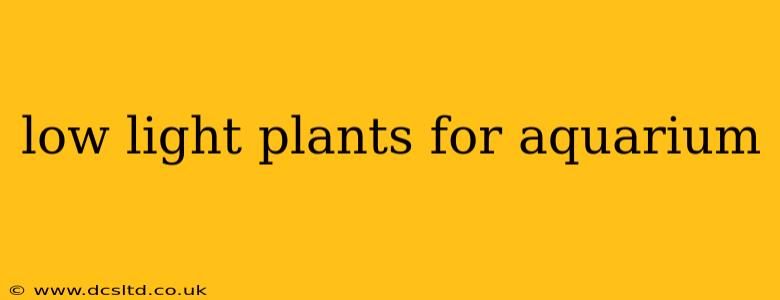Choosing the right plants for your aquarium can significantly impact its overall health and aesthetic appeal. While many aquatic plants thrive in bright light, a surprising number flourish even under low-light conditions. This guide explores various low-light aquarium plants, offering detailed information to help you select the perfect species for your setup. Whether you're a beginner setting up your first aquarium or an experienced aquarist looking to expand your collection, understanding low-light options is crucial for success.
What Defines "Low Light" in an Aquarium?
Before diving into specific plant species, let's clarify what constitutes "low light" in an aquarium context. It generally refers to less than 4-6 hours of indirect sunlight or less than 2-3 watts per gallon of aquarium lighting. Direct sunlight should be avoided as it can lead to algae blooms and harm your fish. Low light conditions can be ideal for beginners, as they often require less maintenance and are less susceptible to algae issues.
Popular Low Light Aquarium Plants: A Diverse Selection
Numerous low-light tolerant plants offer a range of textures, colors, and growth habits. Here are some of the most popular and readily available choices:
1. Anubias Nana:
A popular choice for beginners, Anubias nana is exceptionally hardy and adaptable. Its small size and slow growth make it perfect for smaller tanks or areas where space is limited. Attach it to rocks or driftwood to create a visually appealing landscape.
2. Java Moss (Taxiphyllum barbieri):
This incredibly versatile plant can be tied to rocks, driftwood, or allowed to grow freely on the substrate. Java moss provides excellent hiding places for small fish and invertebrates and is known for its resilience.
3. Java Fern (Microsorum pteropus):
Another highly adaptable species, Java Fern thrives in various conditions, tolerating low light and a wide range of water parameters. It's easy to attach to hardscape elements and creates a lush, natural appearance.
4. Cryptocoryne Wendtii:
Cryptocoryne wendtii boasts attractive foliage and adapts readily to low-light environments. It's a relatively low-maintenance plant that can add a touch of elegance to your aquarium. It prefers to be planted in the substrate.
5. Vallisneria (Eelgrass):
Vallisneria is a fast-growing, easy-to-care-for plant that spreads quickly, creating a dense carpet in the foreground of your aquarium. It can handle low light, though it will grow faster in more intense lighting.
Frequently Asked Questions (FAQs)
Here are answers to some common questions regarding low-light aquarium plants:
What are the best low-light plants for beginners?
For beginners, Anubias nana, Java Moss, and Java Fern are excellent choices due to their hardiness, low maintenance requirements, and tolerance for a wide range of water parameters.
How often should I trim low-light aquarium plants?
Trimming frequency depends on the plant's growth rate. Fast-growing species like Vallisneria may need trimming every few weeks, while slow-growing plants like Anubias nana require less frequent maintenance. Regular pruning encourages bushier growth and prevents overcrowding.
Will my low-light plants still grow without CO2 injection?
Most low-light plants will grow without CO2 injection, although growth may be slower. CO2 supplementation will generally boost growth rates, even in low-light conditions. However, it's not a necessity for many low-light species.
Can I use low-light plants in a heavily planted tank?
Yes, many low-light plants can be used in a heavily planted tank, but you may need to strategically place them to ensure they receive adequate light. Taller, faster growing plants should be placed in the back, allowing smaller, slower growing plants to receive some light.
What are some common problems with low light plants?
Common problems include algae growth (especially if there is nutrient excess), melting (plants adapting to a new environment), and slow growth. Maintaining good water parameters and avoiding overfeeding are crucial for preventing these issues.
Conclusion: Illuminating Your Low-Light Aquarium
Choosing the right low-light plants can transform your aquarium into a thriving, aesthetically pleasing ecosystem. With their resilience and low-maintenance characteristics, these plants are perfect for both beginners and seasoned aquarists alike. Remember to research the specific requirements of each species to ensure its long-term health and success within your aquarium environment. Remember, patience is key when establishing a planted tank. Give your plants time to adapt and enjoy the process of creating a beautiful underwater world.
